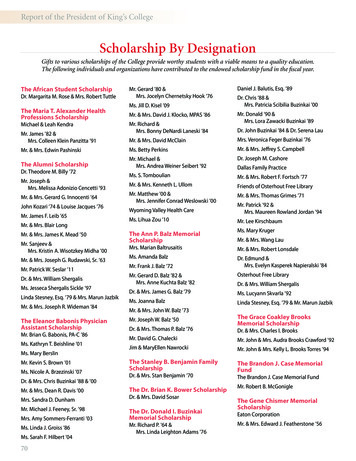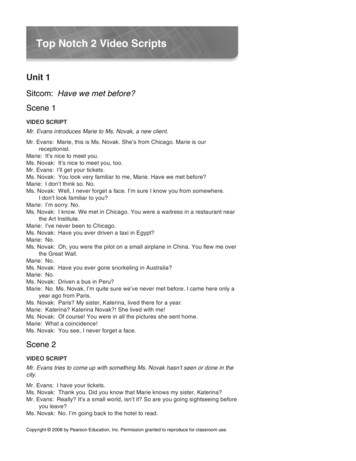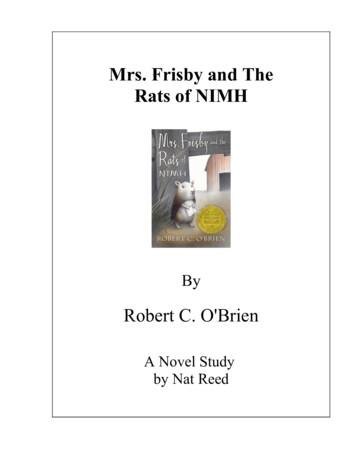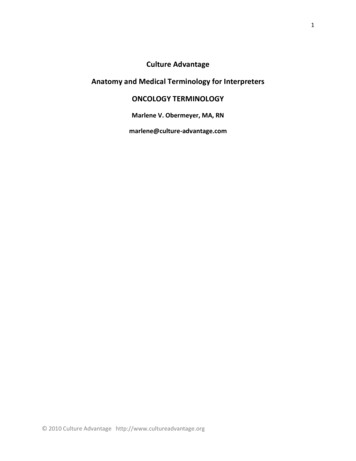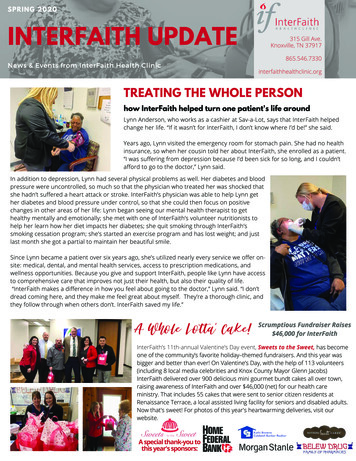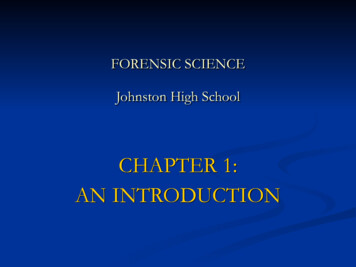
Transcription
FORENSIC SCIENCEJohnston High SchoolCHAPTER 1:AN INTRODUCTION
Chapter 1 Organization Lesson 1: History of Forensic Science Honors: Research a Forensic Scientist Assignment Lab: Locard LabLesson 2: Growth and Organization of the Crime Lab Look at URI Crime Lab and Department of HealthLesson 3: Specialized Services in Forensic Science Focus and Lab: Forensic Entomology Q1 Project: Career Exploration in Forensic ScienceLesson 4: Admission of Evidence into Court Cases: Frye vs US and Coppolino vs StateLesson 5: The Forensic Scientist Meet a Forensic Scientist (Guest Speaker)
What is FORENSIC SCIENCE? Definition: The application of SCIENCEto the criminal and civil laws that areenforced by police agencies in a criminaljustice system. Criminal laws – murder, theft, rape, etc. Civil laws – regulate food quality, environment,pesticides, prescription drugs
History of Forensics – Initial Advances Breakthroughs in anatomy and chemistry (late1700’s) Carl Wilhelm Scheele and Valentin Ross: found waysto detect poisons (arsenic) in body tissuesMathieu Orfila – Father of Forensic Toxicology Tested the effects of poisons on animals
History of Forensics – Later Progress The Bertillon System First method of personal/criminal identificationMade by French ethnologist Alphonse BertillonAnthropometry Systematic procedure taking many body measurementsEventually replaced by fingerprints
Bertillon’s System of BodyMeasurements
More advancements Francis Henry Galton First to classify fingerprintsFirst to prove that fingerprints are uniqueHans Gross (1893) Applied many scientific disciplines and scientificmethod to the field of criminal investigation Microscopy, chemistry, zoology, botany, physics, etc.
Who is the best known 19th c. figure? Sherlock Holmes Fictional, but many believecreator Sir Arthur ConanDoyle popularized crimedetection methods
20th Century Breakthroughs Dr. Karl Landsteiner Dr. Leon Lattes (1915) Discovered that blood can be grouped (A, B, AB, O)Simple procedure for determining blood group ofdried blood stainAlbert S. Osborn Developed principles for document examination
More key figures Dr. Walter C. McCrone Expert microscopistApplied microscopy to analytical problems inforensicsCalvin Goddard Used microscopy to study ballisticsComparing bullets from various guns
Locard’s Principle Frenchman Edmund Locard Founder of Institute of Criminalistics at theUniversity of LyonsLocard’s Prinicple When two objects come into contact with each other,a cross-transfer of materials occurs.In other words EVERY CONTACT LEAVES ATRACE!
CHECKING POINT 1* END of Lesson 1 (History)* What’s Next* Locard Lab* Mini Quiz on Forensic ScienceHistory* After that, let’s move onto Lesson 2(Growth and Organization of theCrime Lab)12
CRIME LABS - Background Oldest Forensics Lab LAPD (1923)FBI (under J. Edgar Hoover) organized nationallab in 1932 – available to all law enforcementagencies across US Largest forensics labModel for state/local labsEach state has city, county, and state labs Roughly 350 public crime labs
Growth of Crime Labs1)2)Supreme Court decisions in the 1960’s placedgreater emphasis on evidence acceptance/evaluationIncrease in crime rates over last 40 yrs.1)3)More drug-related arrests – chem. analysisBeginning of DNA profiling1)Blood, semen, hair, saliva INDIVIDUALIZATION
Major Crime Labs in US (History)1)2)3)4)FBI (Dept. of Justice) – Quantico, VADrug Enforcement Administration Lab (Dept.of Justice)Bureau of Alcohol, Tobacco, Firearms, andExplosives (Dept. of Justice)US Postal Inspection Service
In Rhode Island 1) Rhode Island State Crime Laboratory* Located on the University of Rhode Island* Evidence Examined: Firearms, projectiles, fingerprints,trace evidence, tool marks, fire debris* http://web.uri.edu/riscl/Pictured Left: DirectorDennis Hilliard
Rhode Island State Crime Laboratory* A few videos* https://youtu.be/kYAxx4cUZcE (Woonsocket Case)* RISP Mobile Crime Lab https://youtu.be/xw8GVdH0SLo2) Rhode Island Department of Health, Center forForensic ScienceLocated in ProvidenceEvidenceExamined: Drugs, Biological Samples (Blood, DNA),https://youtu.be/xw8GVdH0SLodrunk driving cases, sexual assault cases, death ail.php?pgm id 135Services: nsicSciencesLaboratoryServices.pdf17
BasicUnits of a :FirearmsBulletsCartridge casesShotgun shellsTool MarksGun ShotResidue (GSR)Toxicology:Drugs andpoisons inorgans andbody fluidsDocumentExamination:? documentsErasuresForgeriesPaper/inksPolygraph UnitEvidenceCollection amination18
CHECKING POINT 2* END of Lesson 2 (Growth andOrganization of the Crime Lab)* What’s Next* Mini Quiz on Growth andOrganization of the Crime Lab* After that, let’s move onto Lesson 3(Specialized Services of the CrimeLab)* We will be presenting Career Projects anddoing an Entomology Lab19
Other Specialized Services (may not bewithin the crime lab) Forensic Pathology Investigation of sudden, unnatural, unexplained orviolent deathsAutopsy performed to establish the cause of death5 categories of death: natural, homicide, suicide,accident, or undeterminedTime of death may also be determined
Other Forensic Science Services Forensic Anthropology Identification and examination of skeletal remainsBones can reveal species, sex, approximate age, possible ethnicity, andskeletal injuryFacial reconstruction can help identify “John or Jane Doe”
Other Forensic Science Services Forensic Psychiatry Study of human behaviorDetermine if persons are competent to stand trialDevelop a suspect’s behavioral profile based onprevious patterns of other criminals
Ted Bundy, Serial Killer Educated individualConfessed to over 40 murders All young femaleMurdered with blunt instrument/rapedHow did he finally get caught?Forensic ODONTOLOGY!
Other Forensic Science Services Forensic Odontology Study of teeth characteristics, alignment and theoverall structure of the mouth to identify a personBite mark analysis compares marks on a victim to theteeth of the suspect
Other Forensic Science Services Forensic Engineering Investigation of structural failures, accidentreconstruction and causes of firesAttempts to determine if human intervention causedthe structural failureUtilizes computer models and architectural models tohelp courts visualize crime scenes
Other Forensic Science Services Forensic Entomology Study of insects to estimate the time of deathStages: Adult, Eggs, Larva, Pupa, AdultStages of development tell how long ago the eggswere laid – age of oldest insect on the body dictatesminimum time since deathTemperature and other weather conditions affect thedevelopment
Forensic Entomology – Lab Background Blowflies (Diptera Calliphora) detect carcasseswithin a few hours after deathBlowfly egg masses – usually laid in bodyopenings
Entomology – more background Larva (maggots) come in three stages - primary,secondary, tertiaryoften are found around body openings andwounds
Fly Pupae Background Largest larval stageForms dark brown casing Usually left in soil under/around food sourceSometimes wander anywhere from 3m-10m fromcarcass
Adult Blowfly
Rate of Development depends on Temperature Higher the temp, the faster the insects will develop
Timeline Under normal conditions, eggs hatch in 8-12hoursMaggots take 3-4 days to reach full sizeMaggots pupate 1-2 days laterAdults hatch from pupa after 6-8 days Able to lay eggs 5 days laterSo how long has a body been dead if you find adultflies on it?13-15 days!
Circle of Life
In the past Day 1
Egg masses a few days later
Larger Larvae
CHECKING POINT 3* END of Lesson 3 (SpecializedServices of the Crime Lab)* What’s Next* Continuing to present Career and EntomologyProjects* No quiz on this lesson, but you must know thematerial for the Ch. 1 Test* Let’s move onto Lesson 4(Admissibility of Evidence into Court)37
The Science of Evidence Procedures and techniques used to examine evidencemust satisfy criteria of admissibility established bycourts (Frye Standard and Federal Rules of Evidence)Frye v. US (admissibility of polygraph)Just when a scientific principle or discovery crosses the line between theexperimental and demonstrable stages is difficult to define. Somewhere inthis twilight zone the evidential force of the principle must be recognized,and while the courts will go a long way in admitting expert testimonydeduced from a well-recognized scientific principle or discovery, the thingfrom which the deduction is made must be sufficiently established to havegained general acceptance in a particular field in which it belongs.
Frye Standard Court decides if procedure, technique, orprinciple is “generally accepted” by majority ofrelevant scientific communityWhat do you think were some pros and cons of admittingevidence under this standard?
Federal Rules of Evidence More flexible standard that does not rely ongeneral acceptance as standard for admittingevidenceAdmissibility of all evidence Including expert testimonyAllows for new evidence new testing techniques new scientific evaluations
Daubert v. Merrell Dow Pharmaceuticals, Inc. 1993, court stated that Frye Standard or “generalacceptance” is not an absolute prerequisite toadmissibility of evidenceFederal Rules of Evidence (#702) – ensures thatexpert testimony rests on reliable foundation andis relevant to caseJudges ultimately act as gatekeeper in admittingevidence
Questions asked by judge whenadmitting evidence 1) Can the scientific technique/theory be tested?2) Is the technique/theory subject to peer review orpublication?3) What is the technique’s potential rate of error?4) What maintenance of standards exist whencontrolling the technique’s operation?5) Has this technique/theory attracted widespreadacceptance in the scientific community?
How can you relate this to Coppolino v.State? Does a new procedure (detecting succinic acid inbrain) allow for admissibility of evidence incourt? Not known amongst widespread communityCourt stated that researchers MUST devise newscientific tests to solve special problems thatcontinually arise in forensics
CHECKING POINT 4* END of Lesson 4 (Admissibility ofEvidence into Court)* What’s Next* Mini Quiz on Evidence Admissibility (focus ontwo cases we discussed)* Let’s move onto Lesson 5 (TheForensic Scientist)44
FORENSIC SCIENTIST Independent Finders of FACTTestify to TRUTHUse tests that are RELIABLEACCURATEREPRODUCIBLEUNBIASED Evidence cannot be influenced by theories
FORENSIC SCIENTIST DATA is basis of all conclusionsACCURATE DATA is derived from carefulcollection of evidencePOOR EVIDENCE COLLECTION ORHANDLING can result in wrong conclusionsGarbage in – garbage outDOCUMENTATION IS ESSENTIAL
Forensic scientists must be properlytrained in RecognitionCollectionAnd Preservation of Physical Evidence Law Enforcers in RI trained as Crime SceneInvestigators through the BCI Courses at URI
Forensic Scientists Provides ExpertTestimony Expert witness: individual whom the courtdetermines to possess a particular skill orknowledge in a trade or profession that is notexpected of the average layperson and that willaid the court in determining the truth of a matterat trial.
Forensic Scientists Provides ExpertTestimony Expert in knowledge, skill, experience, training, oreducation may offer testimony if 1) testimony based on sufficient facts or data2) testimony is product of reliable scientific principles3) witness has applied principles and methods reliably to thefacts of the caseDNA Expert Testimony in the AaronHernandez trial https://youtu.be/kOG9U7LC1wgExpert Testimony in Hollywood:https://youtu.be/3nGQLQF1b6I49
CHECKING POINT 5END OF CHAPTER 1* What’s Next* Chapter 1 Test
Chapter 1 Organization Lesson 1: History of Forensic Science Honors: Research a Forensic Scientist Assignment Lab: Locard Lab Lesson 2: Growth and Organization of the Crime Lab Look at URI Crime Lab and Department of Health Lesson 3: Specialized Services in Forensic Science Focus and Lab: Forensic Entomology Q1 Project

